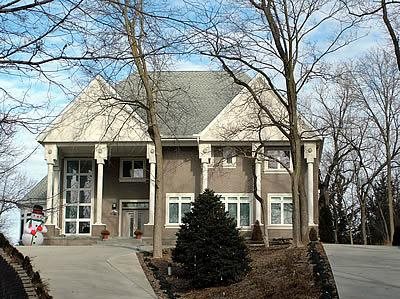- Concrete Homes Home
- Concrete Homes Pictures
- Do Concrete Homes Cost More?
- Optimizing the Energy Efficiency of an ICF Home
- Design Ideas for Concrete Homes
- Related Information
- Building Concrete Safe Rooms
- Going Green with Concrete: An Overview of Concrete's Eco-Friendly Benefits
- Tilt-Up Concrete Construction
- Building a Concrete Basement
- Other Resources
- Concrete Home Infographic
- Free Brochures
- Concrete Contractors: Find Concrete Form Products and Suppliers
Section Sponsor

Concrete Homes
How Much Does a Concrete House Cost?
Many homeowners assume that a concrete home will cost considerably more than a comparable stick-built house. But in reality, you may actually save money by building with concrete when you factor in life-cycle costs, utility and insurance savings, maintenance requirements and overall health of the occupants.
Other important benefits you can't put a price tag on include increased safety from disasters and comfort from even temperatures throughout the home, improved air quality and decreased outdoor noise levels, all equating to better quality of living due to a healthier, safer environment.
Project Estimator: Calculate how much you might pay to build an ICF home with this online tool from Fox Blocks.
DO CONCRETE HOMES COST MORE?
Historically, the cost to construct an ICF home has been slightly higher than a comparable wood-frame home. According to a study by the National Association of Home Builders the average new home in 2019 was around 2,600 square feet and cost about $300,000 to build. At that time, building a concrete home with ICFs would add 3 to 5% to the price. This would increase costs by $9,000 to $15,000, for a total construction cost of between $309,000 and $315,000.
However, this comparison no longer applies since lumber prices have risen 70% over pre-pandemic levels. This jump adds an average of $36,000 to the cost of building a new home (bringing it to $336,000). In a post about the cost of framing a house from June 2021, FoxBlocks, an ICF manufacturer, points out that “the skyrocketing material costs of lumber and steel erase the cost advantage they once had over ICF.”
CONCRETE HOME COST
$312,000
2600 square feet
$120 per square foot
WOOD-FRAME HOME COST
$336,000
2600 square feet
$129 per square foot
Bottom line: Prior to the pandemic, you would have paid more to build an ICF home, but now you may actually pay less.
COST SAVINGS
Heating and cooling costs and equipment
Field comparisons done by U.S. Department of Housing and Urban Development found that “ICF wall construction can provide a 20 to 25 percent savings in annual heating and cooling costs.” Just how much you'll save depends on many factors, including the thickness of the walls, the number and types of windows and doors in your home, ceiling insulation, the size and efficiency of the heating and cooling equipment, and the climate in the region where you live. What's more, ICF construction allows the installation of smaller heating and cooling equipment, which can save you hundreds or even thousands of dollars in upfront costs.
Insurance
You can also recoup your investment in a concrete home with big savings in insurance costs. Many agencies offer discounts on homeowner's insurance policies of up to 25% for ICF homes because of their resistance to fire, tornadoes, hurricanes and earthquakes.
Energy Efficient Mortgage (EEM)
Homeowners planning to build or purchase an ICF home may qualify for an Energy Efficient Mortgage (EEM), which allows borrowers to qualify for a larger mortgage as a result of the savings in energy expenses. This would give the owner the ability, for example, to invest more in an ICF home because of the lower monthly heating and cooling bills. For more information, read the U.S. Department of Housing & Urban Development's Energy Efficient Mortgage Program.
Maintenance
Costs to maintain an ICF home through the years may be considerably lower due to its resistance to dry rot, pests such as termites and other forms of degradation.
COST CONSIDERATIONS
Additional costs and challenges may occur with window and door installation due to the increased wall thickness. There may also be some impact on plumbing, HVAC or electrical installations, as well as certain architectural features. Due to increased weight of the building, there may also be increased requirements for the foundation.
Read more information on HUD’s findings, Costs and Benefits of Insulating Concrete Forms for Residential Construction.





